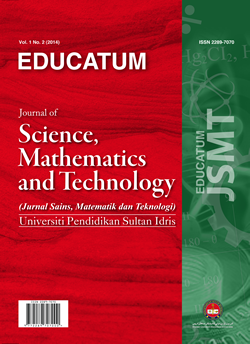Evaluation of Column-Wise Manipulations on Ultra-Performance Liquid Chromatography (UPLC) Data for Forensic Soil Discrimination
DOI:
https://doi.org/10.37134/ejsmt.vol9.1.10.2022Keywords:
forensic science; soil analysis; robust autoscaling; autoscaling; ultra-performance liquid chromatography (UPLC)Abstract
Soil is one of the most encountered physical evidence and can be useful in tracing the location of the crime scene. The discrimination of soils is fundamental to provide a link between a suspect and a crime scene. However, discrimination study of soils could be difficult due to interferences in the chemical fingerprint of soils obtained via a chemical instrumental technique. In this study, performances of four column-wise manipulations (CWMs) on ultra-performance liquid chromatography (UPLC) data of soils were evaluated. Both univariate and multivariate exploratory tools have been employed to elucidate discriminative capability of the preprocessed UPLC data. Results showed that CWMs hardly caused any positive impact to the UPLC data.
Downloads
References
[2]. Fitzpatrick, RW 2009, Soil: Forensic Analysis, in Jamieson, A & Moenssens, A (eds) Wiley Encyclopedia of Forensic Sciences, John Wiley, Chichester, pp. 2377-2388.
[3]. Morgan, RM, Scott, KR, Ainley, J & Bull, PA 2019, ‘Journey history reconstruction from the soils and sediments on footwear: An empirical approach’, Science & Justice, vol. 59, pp. 306-316.
[4]. Uitdehaag, S., Wiarda, W., Donders, T.H. & Kuiper, I. 2016. Forensic Comparison of Soil Samples Using Nondestructive Elemental Analysis. Journal of Forensic Sciences. 62 (4): 861-868.
[5]. Cox, RJ, Peterson, HL, Young, J, Cusik, C & Espinoza, EO 2000, ‘The Forensic Analysis of Soil Organic by FTIR’, Forensic Science International, vol. 108, pp. 107-116.
[6]. Sangwan, P, Nain, T, Singal, K, Hooda, N & Sharma, N 2020, ‘Soil as a tool of revelation in forensic science: a review’, Analytical Methods, vol. 12, pp. 5150-5159.
[7]. Reidy, L, Bu, K, Godfrey, M & Cizdziel, JV 2013, ‘Elemental fingerprinting of soils using ICP-MS and multivariate statistics: A study for and by forensic chemistry majors’, Forensic Science International, vol. 233, pp. 37-44.
[8]. Kikkawa, HS, Naganuma, K, Kumisaka, K & Sugita, R 2019, ‘Semi-automated scanning electron microscopy energy dispersive X-ray spectrometry forensic analysis of soil samples’, Forensic Science International, vo. 305, pp. 109947.
[9]. McCulloch, G, Morgan, RM & Bull, PA 2016, ‘High Performance Liquid Chromatography As A Valuable Tool For Geoforensic Soil Analysis’, Australian Journal of Forensic Sciences, vol. 49, pp. 421-448.
[10]. McCulloch, G, Dawson, LA, Brewer, MJ & Morgan, RM 2017, ‘The identification of markers for Geoforensic HPLC profiling at close proximity sites’, Forensic Sciences International, vol. 272, pp. 127-141.
[11]. Slosse, A, Van Durme, F, Samyn, N, Mangelings, D & Vander Heyden, Y 2020, ‘Evaluation of data preprocessings for the comparison of GC-MS chemical profiles of seized cannabis samples’, Forensic Science International, vol. 310, pp. 110228.
[12]. Wei, X., Shi, X., Kim, S., Zhang, L., Patrick, J.S., Binkley, J., McClain, C. & Zhang, X. 2012. A data pre-processing method for Liquid Chromatography Mass Spectrometry-based Metabolomics. Analytical Chemistry 84: 7963-7971.
[13]. Eriksson, L, Byme, T, Johnansson, E, Trygg, J & Vikstrom C 2013, Multi- and Megavariate data analysis: Basic principles and applications, 3rd edn, UMETRICS Academy.
[14]. Lee, LC, Liong, CY & Jemain, AA 2018, ‘Effects of Data Pre-processing Methods on Classification of ATR-FTIR Spectra of Pen Inks Using Partial Least Squares-Discriminant Analysis (PLS-DA)’, Chemometrics and Intelligent Laboratory Systems, vol. 182, pp. 90-100.
[15]. Lee, LC, Liong, CY & Jemain AA 2017, ‘A Contemporary Review on Data Preprocessing (DP) Practice Strategy in ATR-FTIR Spectrum’, Chemometrics and Intelligent Laboratory Systems, vol. 163, pp. 64-75.
[16]. Engel, J, Gerretzen, J, Szymanska, E, Jansen, JJ, Downey, G, Blanchet, L & Buydens, LMC 2013, ‘Breaking with Trends in Pre-processing?’, Trends in Analytical Chemistry, vol. 50, pp. 96-106.
[17]. Ameeta, NE 2020, ‘Pembeza Layan Sampel Tanah Keperangan dengan Menggunakan Teknik Kromatografi Cecair Berprestasi Ultra (UPLC)’, BSc thesis, Universiti Kebangsaan Malaysia, Selangor.
[18]. Anas, Z 2020, ‘Pembeza Layan Sampel Tanah Kemerahan dengan Menggunakan Teknik Kromatografi Cecair Berprestasi Ultra (UPLC) ’, BSc thesis, Universiti Kebangsaan Malaysia, Selangor.
[19]. Syahiera, K 2020, ‘Pembeza Layan Forensik Sampel Tanah Berwarna Perang Kekuningan dengan Menggunakan Teknik Kromatografi Cecair Berprestasi Ultra (UPLC)’, BSc thesis, Universiti Kebangsaan Malaysia, Selangor.
[20]. Pye, K 2007, Geological and Soil Evidence: Forensic Applications, CRC Press, Boca Raton.
[21]. R Core Team, 2020, R: A language and environment for statistical computing. R Foundation for Statistical Computing, Vienna, Austria. Available: http://www.R-project.org/
[22]. Bro, R & Smilde, AK 2014, ‘Principal component analysis’, Analytical Methods, vol. 6, no. 9, pp. 2812-2831.
[23]. Lee, LC, Liong, CY & Jemain, AA 2017, ‘The Effects of Column-Wise Manipulations on Accuracy of Classical Classifiers with High-Dimensional Spectral Data’, American Institute of Physics, vol. 1830, no. 1, pp. 08008(1)-08008(5).
Downloads
Published
Issue
Section
License
Copyright (c) 2022 Loong Chuen Lee, Nadirah Abd Hamid, Nur Ain Najihah Mohd Rosdi, Hukil Sino

This work is licensed under a Creative Commons Attribution-NonCommercial-ShareAlike 4.0 International License.





